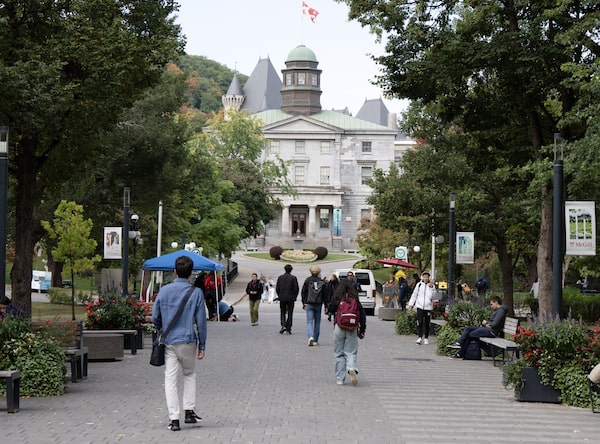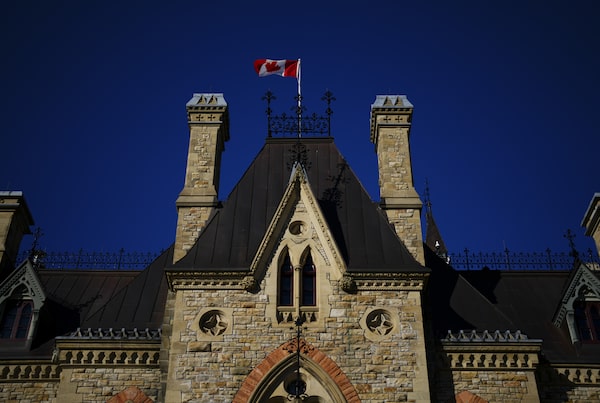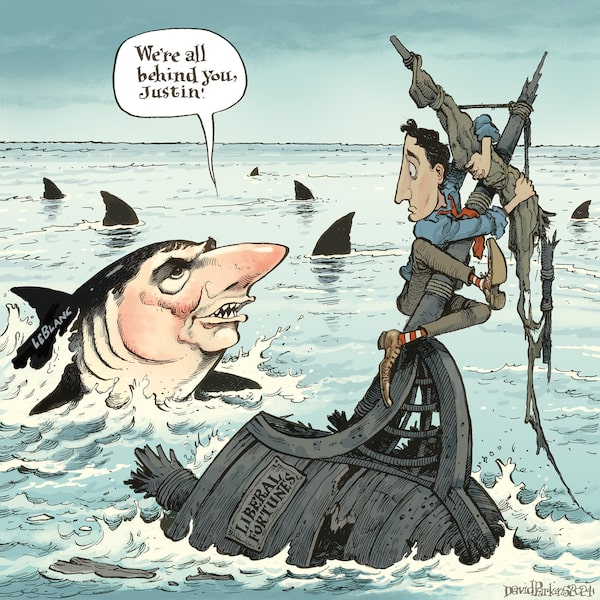Good morning,
Figures obtained by The Globe and Mail show that asylum claims by international students have risen more than 1,500 per cent within the past five years, as experts warn that the study-permit system is being exploited as a route to claim refugee status to remain in Canada.
The massive increase is most drastic at colleges, where figures at some schools have climbed in excess of 4,000 per cent since 2018. Students at major universities, however, tend to lodge fewer claims than at colleges. The increase in asylum claims coincides with a steep rise in the number of international students arriving here, which the government has now taken steps to reduce, partly to ease pressure on housing.

McGill University is seen in Montreal, Oct. 13, 2023.Ryan Remiorz/The Canadian Press
This is the daily Morning Update newsletter. If you’re reading this on the web, or it was forwarded to you from someone else, you can sign up for Morning Update and more than 20 other Globe newsletters on our newsletter sign-up page.
China-affiliated institute compiled profiles of Canadian MPs of Chinese descent
Two sources have told The Globe and Mail that a research institute in China affiliated with its ruling Communist Party’s foreign influence operations compiled extensive profiles of all members of Parliament of Chinese ethnicity in 2022.
The sources say this Chinese institute used big data analytics and artificial intelligence to create detailed profiles of these MPs. There are fewer than 10 MPs of Chinese descent in Canada’s House of Commons.
The profiles were drawn up by a research institute that supports the work of China’s United Front Work Department, a body that answers to the CPC’s central committee. UFWD oversees Beijing’s influence, propaganda and intelligence operations inside and outside China. The Globe and Mail has been unable to confirm the name of the institute.

A Canada flag flies on top of the West Block on Parliament Hill in Ottawa on April 16, 2024.Sean Kilpatrick/The Canadian Press
As deadline nears, global pandemic treaty talks hobbled by delays and quarrels
The pandemic treaty was once touted as a historic decision to ensure fairness and equity in future health crises – unlike during the height of the COVID-19 pandemic, when billions of people were left without vaccines in lower-income countries, causing an estimated 1.3 million deaths – while richer countries built huge stockpiles to safeguard themselves.
But more than two years later, with a deadline looming in just over a month, the treaty negotiations are badly stalled. Wealthy countries, including Canada, are pushing for weak language and vague aspirations on crucial issues such as vaccine-sharing mechanisms. Governments are squabbling over almost every line in the latest 110-page draft of the proposed agreement. There are almost 5,000 brackets in the latest version, with each of the brackets signalling objections or caveats by various countries.
To worsen the situation, the treaty has been dogged by persistent conspiracy theories and disinformation campaigns on social media, including the false claim that it would create a global regime with the power to use military force to impose lockdowns and eliminate freedoms. This has eroded the political support that the treaty needs, analysts say.

Workers transport the second shipment of the Johnson & Johnson Covid-19 coronavirus vaccine upon its arrival at the O R Tambo International Airport in Johannesburg on Feb. 27, 2021.KIM LUDBROOK/Getty Images
It’s a race against time for Ukraine as it awaits the expected approval of US$61-billion in long-delayed U.S. military aid and the U.S. government scrambles to dispatch weapons to Kyiv to hold off Russian advances. Questions are being raised on whether it will be enough to turn the tide.
The U.S. House of Representatives authorized the funds after an about-face by Republican Speaker Mike Johnson, setting the stage for swift passage by the Democrat-led Senate and approval from President Joe Biden, who has been pressing for the money for six months. The Biden administration has warned that, without the money, Ukraine might lose the war by the end of the year.
Some of the funding will allow the U.S. government to send weapons from its own stockpiles at sites domestically and in Europe, with the money from Congress used to replenish supplies. Some of it, meanwhile, will pay for longer-term supply agreements between Kyiv and U.S. arms dealers.

Rescue workers move through the rubble of a university gymnasium that was destroyed by a Russian missile in Kyiv, Ukraine, on March 25, 2024.BRENDAN HOFFMAN/The New York Times News Service
Got a news tip that you’d like us to look into? E-mail us at tips@globeandmail.com Need to share documents securely? Reach out via SecureDrop
Also on our radar
Netanyahu vows to fight any U.S. sanctions against Israeli military unit: The prospect of direct U.S. sanctions against an Israeli military unit has brought a furious response from the country’s top leaders with Prime Minister Benjamin Netanyahu pledging to fight what he called a “moral low.”
In environment coverage, The Globe’s green evolution has been a steady but imperfect process: On Earth Day, we look back at our coverage on the environment. The Globe has often, if not always, been a fierce advocate for environmental solutions proposed by our best scientific minds. As climate change hits Canadians where they live, that work is more important than ever.
Gildan refreshes its board of directors ahead of shareholder meeting: Gildan Activewear Inc. is reshaping its board of directors as it seeks to choke off a proxy campaign by dissident shareholders ahead of its annual meeting in late May.
Why BCE, Rogers and Telus are all struggling – and their misery is likely to last: A new consensus is quietly forming around Canada’s telecommunications industry – a painful narrative is putting more pressure on the sector’s sinking share prices. After years of easy wins, cable and wireless companies are trapped in a new era of tepid growth, and there are no easy fixes in sight.
What’s at stake as UN plastics treaty talks get under way in Canada: This week in Ottawa, delegates from 174 countries will meet in the hopes of stemming the plastic tide, as Canada hosts the fourth session of the Intergovernmental Negotiating Committee on Plastic Pollution, or INC-4.
Morning markets
World stocks recovered some losses while bonds, oil and gold dipped as investors reversed some of their more defensive positions made going into the weekend on fears of a wider Middle East conflict.
The STOXX 600 was up 0.25 per cent and S&P 500 futures were 0.36 per cent higher after MSCI’s broadest index of Asia Pacific shares outside Japan rose 0.8 per cent. Japan’s Nikkei rose 1 per cent and Hong Kong’s Hang Seng gained 1.77 per cent.
In early trading, London’s commodities-heavy FTSE100 rose 1.29 per cent, the biggest gainer among large European benchmarks. Germany’s DAX advanced 0.21 per cent while France’s CAC 40 slid 0.13 per cent.
The dollar traded at 72.89 U.S. cents.
What everyone’s talking about
Canadian banks are not fighting climate change on their own. They must be legislated
“It may be surprising to hear that increased regulation in the financial sector has become a cri de coeur. Historically, bankers have resisted increased regulation. But there are several reasons why the rules governing Canada’s financial sector, especially when it comes to climate change, must be strengthened.” – Julie Segal and Rosa Galvez
The global economy has become fragmented. Here’s how Canada can help repair it
“Efforts to renew existing global institutions to better reflect current economic realities are important. They are key to promoting the benefits of trade and investment among economies. Nurturing new institutions such as the CPTPP and promoting broad accession to it are effective ways to counter global economic fragmentation caused by the rapid rise in tariffs, restrictions and beggar-thy-neighbour policies of the past few years.” – Paul Jenkins and Mark Kruger
Reckless use of social media threatens wild species and landscapes
“Environmental groups learned long ago that posting heart-tugging photos and videos of remote, little-known natural areas can work wonders in galvanizing public support and generating campaign donations. After all, people need to know about a wild and endangered landscape before they can take an interest in protecting it. But those same images can have a deleterious impact if they funnel crowds to vulnerable places that cannot withstand the foot and vehicle traffic.” – Larry Pynn
Today’s editorial cartoon

David Parkins/The Globe and Mail
Living better
Four ways to minimize the impact of plastics in your clothing
It is estimated that synthetic textiles contribute between 200,000 and 500,000 tonnes of microplastics – pieces less than five millimetres in size – to our oceans each year, making them a leading source of global microplastic pollution. And studies have shown that a lot of this shedding happens when textiles are laundered.
Factors such as the material, makeup, construction and design of your clothing can affect the amount of microfibres that are released during wear and laundry. It’s important for industry and government regulators to work on addressing this problem, but in the meantime, here are some simple ways that you can reduce your microfibre footprint as an individual.
Moment in time: From the archives, 1725
Beringer’s Lying Stones hoax
This image shows a bogus fossil lizard (or salamander) eating an insect.The New York Times
For more than 100 years, photographers and photo editors working for The Globe and Mail have preserved an extraordinary collection of news photography. Every Monday, The Globe features one of these images. This month, we’re showcasing hoaxes.
Even though the world seems full of scammers today, deceptions are as old as fossils. Consider the downfall of a brilliant doctor, Johann Bartholomeus Adam Beringer, dean of the Faculty of Medicine at Germany’s University of Wurzburg. In 1725, Beringer was shown what he believed to be ancient plant and animal limestone fossils – petrified remains of once living creatures – found in a mountainous part of Germany. Impressive, and plentiful. Beringer said in a book he published about the find, “The figures expressed on these stones, especially those of insects, are so exactly fitted to the dimensions of the stones, that one would swear that they are the work of a very meticulous sculptor.” Turns out, he was right. It was all a hoax perpetrated by Wurzburg university students, who played the doctor for a chump with fraudulent specimens subsequently known as Lügensteine, or “lying stones.” Beringer sued the culprits of the scam for fraud, successfully, but his reputation was destroyed. Philip King.
Enjoy today's horoscopes. Solve today's puzzles. Read today's Letters to the Editor.
If you’d like to receive this newsletter by e-mail every weekday morning, go here to sign up. If you have any feedback, send us a note.